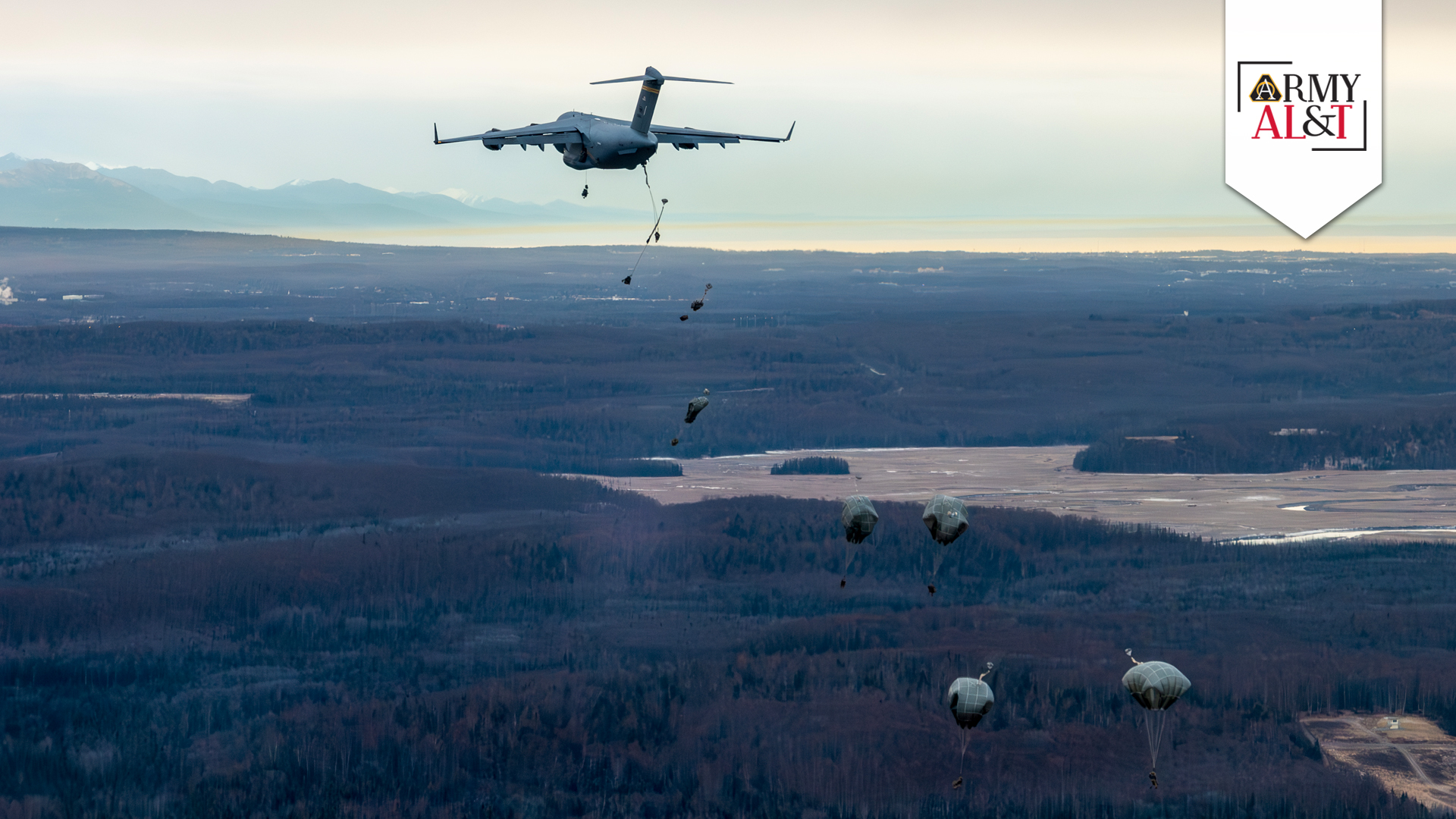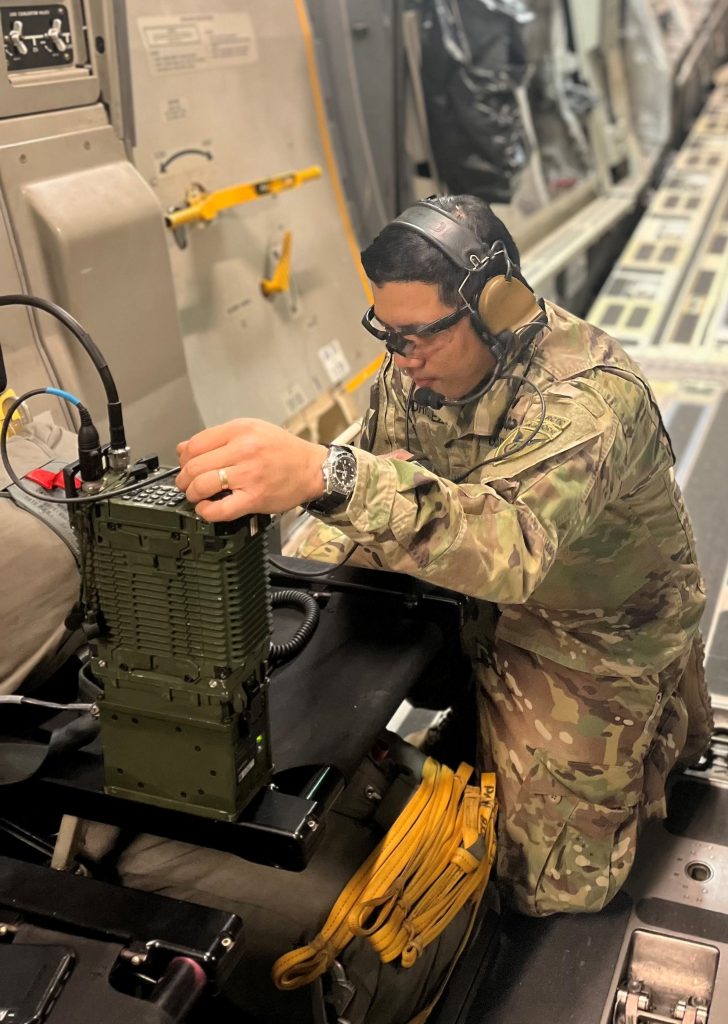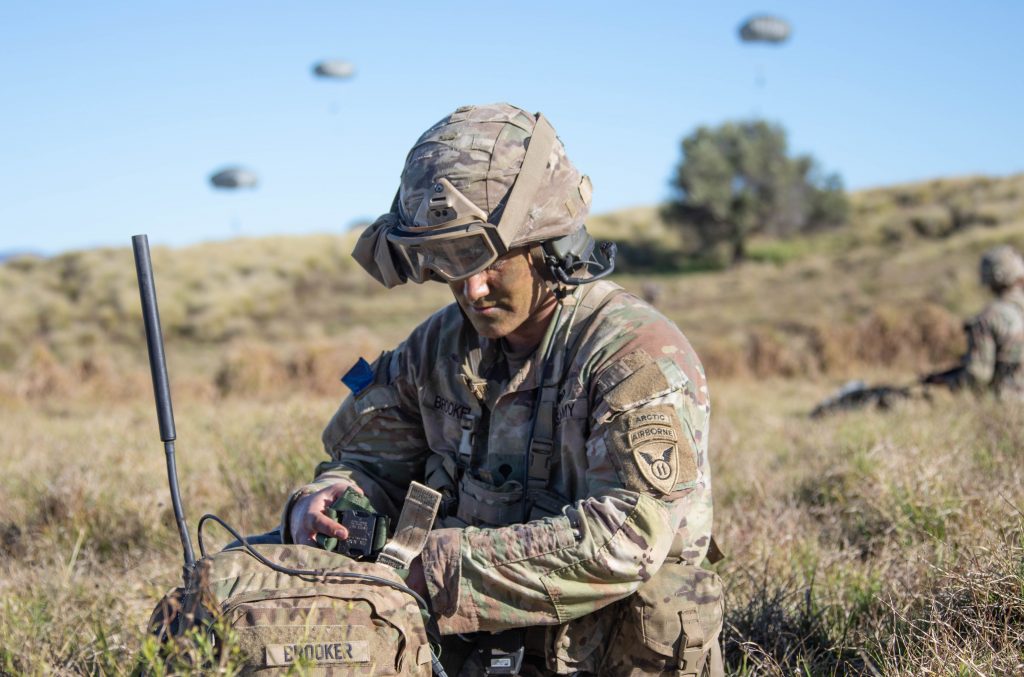
JUMPING THE GUN: U.S. Army Soldiers assigned to 2/11 IBCT(A) conduct a jump from a C-17 Globemaster III during the Joint Pacific Multinational Readiness Center 24-1 exercise at Malemute Drop Zone, Alaska, in November 2023. (Photo by Mysti Bicoy, 154th Wing, Hawaii Air National Guard)
The 11th Airborne Division (Arctic) enabled critical internal communications in-flight.
by Maj. Joey D. Rodriguez
The 2nd Infantry Brigade Combat Team (Airborne), 11th Airborne Division (2/11 IBCT(A)) was the first in the Army to establish push-to-talk, air-to-air and air-to-ground Enroute Mission Command, employing Integrated Tactical Network fielded AN/PRC-158 Mobile User Objective System capable radios internally, removing the involvement of external organizations. This innovation has revolutionized the way the Airborne commander communicates in-flight.

RIGGING THE PLANE: The author, a signal officer for the 2/11 IBCT(A), conducts plane-to-plane radio tests on an installed AN/PRC-158 Mobile User Objective System-capable radio in preparation for an eight-hour cross-Pacific joint forcible entry operation during Arctic Aloha 2024. (Photo courtesy of 2/11 IBCT(A))
COMMS IN-FLIGHT
Traditional Enroute Mission Command, which provides units with critical plane-to-plane and plane-to-ground network communications in short-notice joint forcible entry operations (JFEOs). It employs Key-leader Enroute Node (KEN) and Dependent Airborne Node (DAN) teams from signal organizations that are not organic to the five Army Airborne Infantry Brigade Combat Teams. KEN and DAN teams also require seats within the aircraft to support each mission.
KEN provides airborne units with broadband reach-back data capability; intra-aircraft data and voice communications with subordinate units; secure video teleconferencing; and plane-to-plane and plane-to-ground communications between task force commanders and combatant commanders. DAN enables in-flight subordinate commanders, who are connected with their leaders operating a KEN, to receive critical situational awareness updates through the intra-aircraft data and voice capability using services such as chat and radio voice.
The 2/11 IBCT(A) proved that Airborne Infantry Brigade Combat Teams can establish command and control internally with fielded systems, removing dependencies from these external organizations. Through proper coordination with U.S. Air Force pilots and crew chiefs, Army signal support personnel used the Boeing C-17 Globemaster’s roll-on/off satellite communications panel to patch into and use the existing affixed antennas providing signal transport capabilities. UBI-2590 Battery Eliminator Circuits were also used on AN/PRC-158 multichannel manpack radios to provide continuous uninterrupted power generation using the 120v outlets inside the aircraft. Army signal support personnel installed the radios between the number one and number two jumpers: the Airborne commander and brigade signal officer (S6) seats, enabling easy access for radio calls.

SMOOTH LANDING: A Soldier from the 2/11 IBCT(A) jumps from a C-17 on Pohakuloa Training Area in October 2023. (Photo by Spc. Wyatt Moore, 28th Public Affairs Detachment)
RADIO ON
The 2/11 IBCT(A) tested the communications from the newly configured command and control setup inside the aircraft during four separate joint forcible entry operations. First, in Arctic Aloha 2024, involving two cross-Pacific JFEOs from March Air Reserve Base in California onto the Transfiguracion Drop Zone in Hawaii, followed by a second JFEO, an eight-hour, cross-Pacific, from Hilo International Airport, Hawaii, onto the Malamute Drop Zone in Alaska. The 2/11 IBCT(A) proved the internal setup works a third time during Cobra Gold 2024, executing an 18-hour cross-Pacific JFEO from Alaska to the Tongmin Drop Zone in Thailand. This concept was used successfully again most recently in the first over-the-North Pole JFEO in Norway onto a frozen lake, the Sparrow Drop Zone, during Arctic Edge, also referred to as Northern Edge 2024.
This revolutionary command and control concept enabled the Airborne commander to interface in-flight with the 11th Airborne Division (Arctic) Joint Operations Center on Joint Base Elmendorf-Richardson, Alaska, as well as with the drop zone safety officers during all four JFEOs.
To advance this capability further, with increased funding, the 11th Airborne Division can establish digital command and control with AN/PRC-158 multichannel manpack radios using a Klas 8 Voyager in conjunction with a Tactical Relay Integration Kit (TRIK). The Voyager TRIK provides a lightweight, portable solution for tactical radio networking that serves as a bridge between internet protocol and radio and can be used across multiple aviation platforms and networks, extending the commander’s ability to support the mission.

MAKING CONTACT: JPMRC 24-01 included more than 5,300 participants from across the U.S. Joint Force, New Zealand, the United Kingdom, Indonesia and Thailand, with the aim of generating readiness in the environments and conditions these forces are most likely to operate in. (Photo by Spc. Wyatt Moore, 28th Public Affairs Detachment)
CONCLUSION
The resulting absence of KEN and DAN teams freed additional seats on the aircraft for each Airborne operation. This increased capability enabled the 2/11 IBCT(A) to exit more Paratroopers out the door, therefore increasing movement and maneuver combat power on the objective during the mission. As the U.S. Army focuses on refining its Arctic Strategy, the 11th Airborne Division (Arctic) continues to push the envelope and develop unique command and control solutions in the Arctic, Airborne, high-altitude and high-latitude environments to fight and win tonight.
For more information, contact Maj. Joey D. Rodriguez at joey.d.rodriguez.mil@army.mil.
MAJ. JOEY D. RODRIGUEZ is the signal officer for the 2/11 IBCT(A) in Joint Base Elmendorf – Richardson, Alaska. He holds an M.A. in information technology management from Webster University and a B.S. in aeronautical science from Embry-Riddle Aeronautical University. He is currently qualified as a U.S. Army static-line jumpmaster.







